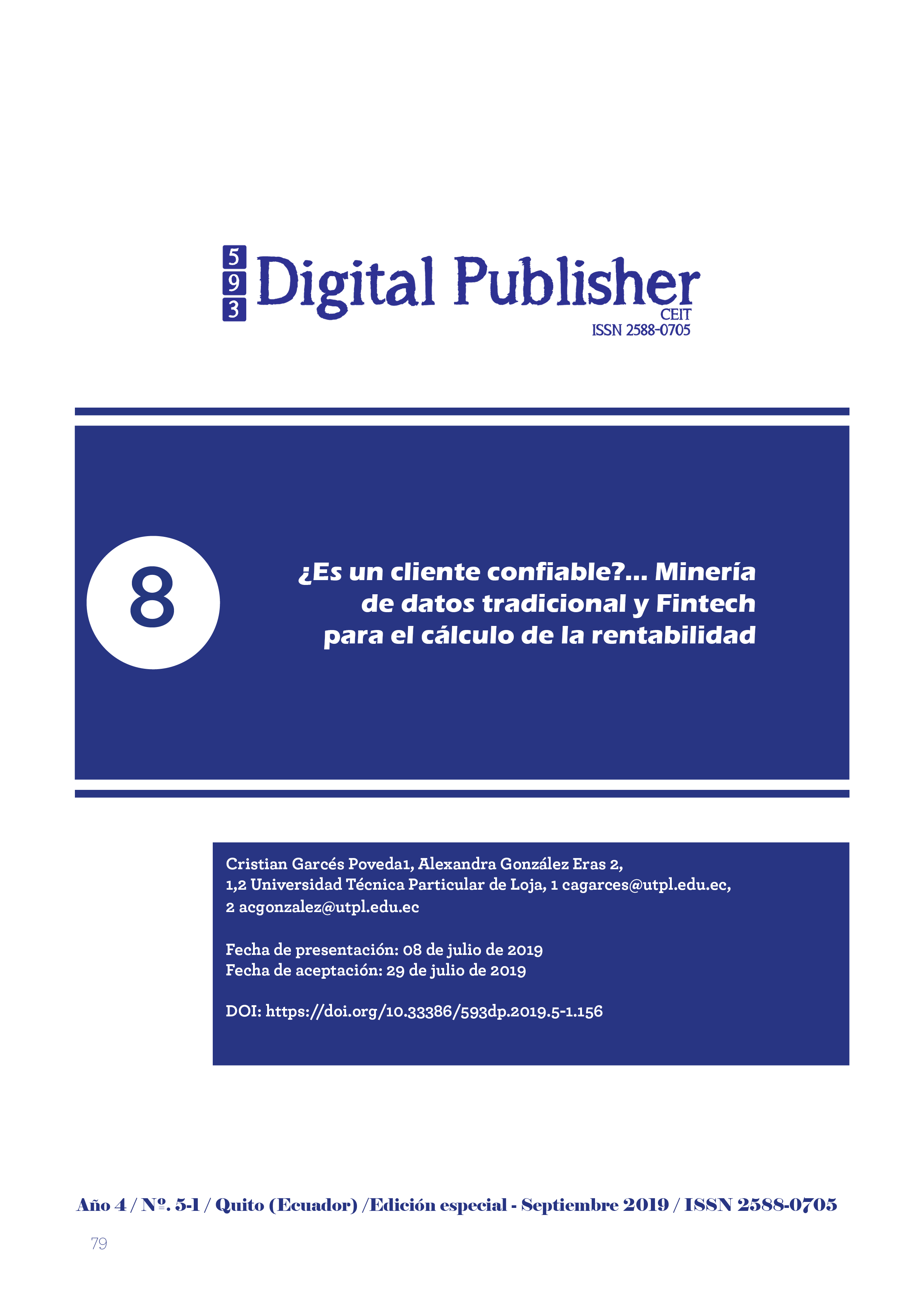Is it a reliable customer? ... Traditional data mining and Fintech for the calculation of profitability
Main Article Content
Abstract
This paper presents a proposal for the detection of reliable corporate clients based on their user profiles in credit institutions, according to an automatic classification model based on neural networks, which achieves high accuracy in relation to traditional learning algorithms. For the development of the mining model, we use an adaptation of the CRISP-DM methodology that allows the creation of a reliable model that can be integrated into cloud service platforms. The implementation of this model offers reduced time to calculate customer profitability; it is easy to apply in corporate services and the visualization of the results for the consultation and decision-making. Thus, the model constitutes a valid Fintech proposal for corporate and finance companies.
Downloads
Article Details
1. Derechos de autor
Las obras que se publican en 593 Digital Publisher CEIT están sujetas a los siguientes términos:
1.1. 593 Digital Publisher CEIT, conserva los derechos patrimoniales (copyright) de las obras publicadas, favorece y permite la reutilización de las mismas bajo la licencia Licencia Creative Commons 4.0 de Reconocimiento-NoComercial-CompartirIgual 4.0, por lo cual se pueden copiar, usar, difundir, transmitir y exponer públicamente, siempre que:
1.1.a. Se cite la autoría y fuente original de su publicación (revista, editorial, URL).
1.1.b. No se usen para fines comerciales u onerosos.
1.1.c. Se mencione la existencia y especificaciones de esta licencia de uso.
References
Aldridge, I., & Krawciw, S. (2017). Real- time risk: What investors should know about FinTech, high-frequency trading, and flash crashes. John Wiley & Sons.
Bonnes, K. (2017). Predicting mortgage demand using machine learning techniques (Master's thesis, University of Twente).
Curto Díaz, J., & Braulio Gil, N. (2015). Customer analytics: mejorando la inteligencia del cliente mediante los datos. Customer analytics, 1-116.
Gironés, J., Casas, J., & Minguillón, J. (2017). Minería de datos: modelos y algoritmos”. Editorial UOC.
Lin, T. C. (2015). Infinite financial intermediation. Wake Forest L. Rev., 50, 643.
Martin del Peso, M. (2017). Aplicaciones de las redes neuronales artificiales a problemas de predicción y clasificación financiera, Universidad Rey Juan Carlos, Madrid.
Medina Rodríguez, M. D. P., & Ulfe Rentería, H. G. (2017). Modelo de Credit Scoring para Predecir el Otorgamiento de Crédito Personal en Una Cooperativa de Ahorro y Crédito.
Microsoft Power BI customers. Metro Bank case study. Customers.microsoft.com. Retrieved from
https://customers.microsoft.com/en- US/story/building-a-bank-that-can- surprise-and-delight-with-pow
Microsoft power BI customers. Tangerine case study. Customers.microsoft.com. Retrieved from
https://customers.microsoft.com/Pages/ CustomerStory.aspx?recid=14594
Nuñez, J. P., Savoy, F., Retamar, M. S., De Gracia, L., De Battista, A. C., & Ramos, L. M. M. (2018). Minería de datos para la detección de factores de influencia en el test Apgar.
Pacco Palomino, R. (2015). Análisis predictivo basado en redes neuronales no supervisadas aplicando algoritmo de kmedias y crisp-dm para pronóstico de riesgo de morosidad de los alumnos en la Universidad Peruana Unión.
Santiesteban, E., Fuentes, V., & Leyva,
E. (2011). Análisis de la rentabilidad económica: tecnología propuesta para incrementar la eficiencia empresarial. Editorial Universitaria.
Scholten, U. (2017). Banking-as-a- Service - what you need to know. VentureSkies.
Schueffel, P. (2016). Taming the beast: a scientific definition of fintech. Available at SSRN 3097312.
Tase, R. O. R., Cabrera, A. V., Naranjo,
D. L. O., Diaz, A. A. O., & Blanco, I. F. (2016). Nuevo algoritmo multiclasificador para flujos de datos con cambios de concepto/ensemble algorithm for data streams with concept drift. Holos, 32(2), 24.
Venegas, L. (2016). Plan para enfocar las campañas Bancarias utilizando Datamining.

